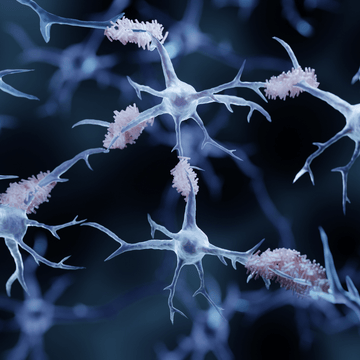Alzheimer’s disease results from neurodegeneration of neurons responsible for cognition: cholinergic neurons. Cholinergic neurons are especially sensitive to decreased membrane fusion activity caused by plasmalogen deficiency because, unlike other neurons, membrane fusion is necessary for both neurotransmitter release and re-uptake. Reduced membrane fusion reduces neurotransmission which reduces cognition.
Parkinson’s disease results from neurodegeneration of neurons responsible for fine motor control: dopaminergic neurons. The direct cause of Parkinson’s is unknown, but some environmental neurotoxins selectively target dopaminergic neurons and cause Parkinson’s in animals. Plasmalogen deficiency increases susceptibility to neurotoxins.
Multiple Sclerosis results from neurodegeneration of cells that insulate neurons: myelin or oligodendrocytes. Myelin has the highest concentration of plasmalogens in the whole body. When immune cells are activated to clean up a mess (inflammation), part of the myelin can be damaged and extra plasmalogens are needed to repair the cells before they die. If cells cannot be repaired before they die, the debris creates even more inflammation and degeneration. High levels of plasmalogens prevent demyelination by improving remyelination.
Plasmalogens prevent neurodegeneration in animal models; the majority of the publications are for Parkinson’s disease. In a mouse model of Parkinson’s disease, an oral dose of plasmalogen at 50mg/kg was fully neuroprotective[i]. Several publications demonstrate the neuroprotective and anti-inflammatory properties in mouse and monkey models of Parkinson’s disease[ii],[iii],[iv],[v].
[i] Miville-Godbout E, Bourque M, Morissette M, Al-Sweidi S, Smith T, Mochizuki A, Senanayake V, Jayasinghe D, Wang L, Goodenowe D, Di Paolo T. Plasmalogen Augmentation Reverses Striatal Dopamine Loss in MPTP Mice. PLoS One. 2016 Mar 9;11(3):e0151020. doi: 10.1371/journal.pone.0151020. eCollection 2016. PubMed PMID: 26959819.
https://www.ncbi.nlm.nih.gov/pubmed/26959819
[ii] Nadeau J, Smith T, Lamontagne-Proulx J, Bourque M, Al Sweidi S, Jayasinghe D, Ritchie S, Di Paolo T, Soulet D. Neuroprotection and immunomodulation in the gut of parkinsonian mice with a plasmalogen precursor. Brain Res. 2019 Dec 15;1725:146460. doi: 10.1016/j.brainres.2019.146460. Epub 2019 Sep 13. PubMed PMID: 31525350.
https://www.ncbi.nlm.nih.gov/pubmed/31525350https://www.ncbi.nlm.nih.gov/pubmed/26959819
[iii] Bourque M, Grégoire L, Di Paolo T. The plasmalogen precursor analog PPI-1011 reduces the development of L-DOPA-induced dyskinesias in de novo MPTP monkeys. Behav Brain Res. 2018 Jan 30;337:183-185. doi: 10.1016/j.bbr.2017.09.023. Epub 2017 Sep 14. PubMed PMID: 28917506.
https://www.ncbi.nlm.nih.gov/pubmed/28917506
[iv] Miville-Godbout E, Bourque M, Morissette M, Al-Sweidi S, Smith T, Jayasinghe D, Ritchie S, Di Paolo T. Plasmalogen precursor mitigates striatal dopamine loss in MPTP mice. Brain Res. 2017 Nov 1;1674:70-76. doi: 10.1016/j.brainres.2017.08.020. Epub 2017 Aug 19. PubMed PMID: 28830769.
https://www.ncbi.nlm.nih.gov/pubmed/28830769
[v] Grégoire L, Smith T, Senanayake V, Mochizuki A, Miville-Godbout E, Goodenowe D, Di Paolo T. Plasmalogen precursor analog treatment reduces levodopa-induced dyskinesias in parkinsonian monkeys. Behav Brain Res. 2015 Jun 1;286:328-37. doi: 10.1016/j.bbr.2015.03.012. Epub 2015 Mar 11. PubMed PMID: 25771209.


